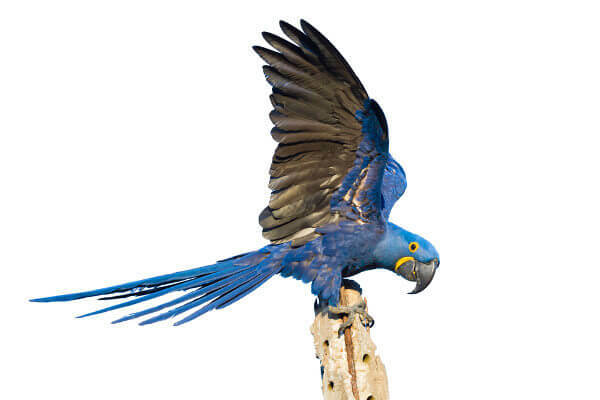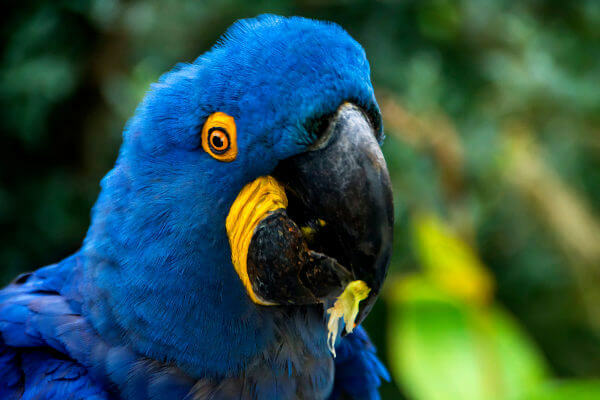The Hyacinth Macaw, also called Hyacinth Macaw, is a species of bird, found in Brazil, which is characterized by being the biggest among parrots (family psittacidae), reaching more than one meter long, measuring from the tip of the beak to the tip of the tail. This species inhabits different plant formations, being found in savanna formations and even in environments of Forest at the Brazil, Paraguay and Bolivia. The largest populations of this species of macaw are found in the Swampland.
Read too:Pantanal Animals
→ Scientific name
The scientific name of the Hyacinth Macaw is Anodorhynchus hyacinthinus. See, below, the taxonomic classification of this animal:
Kingdom: animalia
Phylum:Chordata
Class: birds
Order:psittaciformes
Family:psittacidae
Gender:Anodorhynchus
Species:Anodorhynchus hyacinthinus
Read too:Macaw
→ Features
The hyacinth macaw, as the name suggests, stands out for its blue coloring of its feathers, more precisely the color cobalt blue. An interesting detail is that in the underside of the wings
and of the long tail the color is not blue, as in the rest of the body, but black (see figure below). In the head, you can see a ring of yellow color to the around theeyes. In addition, the yellow color is noticed in the eyelids and base of mouth. O nozzle this animal is great and curved, giving the impression that this one is bigger than the skull itself.
Note the inner part of the macaw's wing, with its black coloration.
This animal also stands out for its size. a hyacinth macaw adult can even reach one meter long and weigh up 1.3 kg. When are born the puppies, feature about 30 grams and a size of about 82 mm.
These animals are birds social, being found in pairs or groups. These groups can be found at food places and in the calls dorms, which function as resting areas for these animals. Hyacinth macaws have a high capacity for socialization among group members.
An interesting feature of the Hyacinth Macaw is that it has monogamous behavior, with the formation of couples that remain together even outside the reproductive season. these pairs divide tasks among themselves, like caring for the chick and the nest.

Hyacinth macaws make nests in tree holes.
After mating, the eggs are placed in nests located mainly in hollow trees is on rocky walls. Generally, the female puts between one and three eggs and is shocking them for an approximate period of one month. During this period, the male is responsible for bringing food to the female. It is common for the macaw couple reuse a nest from one year to another.
In the first months after birth, the Cub is very weak, being subject to predation and also to parasites. These birds remain in the nest for approximately three months, taking flight only after this period. THE pup separation of parents, however, only occurs after about 12 or 18 months.
Read too: Bird characteristics
→ food

The macaw basically feeds on palm fruits.
The hyacinth macaw has a very resistant beak, which helps it to feed. These animals feed mainly on palm fruits, such as buriti, licuri and macauba. Hyacinth macaws are generally observed feedingon the ground and in flocks, unlike most species of macaws that feed on tree tops. THE group feeding is an important way of protection.
→ Is the Hyacinth Macaw extinct?
the hyacinth macaw (Anodorhynchus hyacinthinus)is a species that is not extinct, but it is classified as vulnerable at Red List of Endangered Species, of the International Union for the Conservation of Nature and Natural Resources (IUCN). Also according to this list, the population of this species is decreasing. At main threats against her are the habitat destruction and the capture for illegal trade.
→ the blue colored macaws
Many people call all blue colored macaws hyacinth macaws, however, in the group of hyacinth macaws, we have various species. The name hyacinth macaw is more used to refer to the species Anodorhynchus hyacinthinus, also called the Hyacinth Macaw. In addition to the hyacinth macaw, we have as blue colored macaws: the Spix's Macaw (extinct), the Lear's Macaw and the little hyacinth macaw (extinct). See a little more about them:
Spix's Macaw: it is a species of macaw with a blue coloration, but it has a smaller size when compared to other species. this is totally blue, with a lighter color on the head than the rest of the body. Currently, the Spix's Macaw (Cyanopsitta spixii) is extinct in nature.

The Lear's Macaw is a species found in Brazil.
Lear's Macaw: has the scientific name Anodorhynchus leari. your head and neck receive the blue-green coloration, and around the eyes there is a pale yellow ring. The belly of this animal has a more faded color, while wings and tail are cobalt blue. It is quite similar to the hyacinth macaw, being, however, smaller, presenting little more than 70 cm. This species, due to conservation programs, today has a rising trend.
Little Hyacinth Macaw: whose scientific name is Anodorhynchus glaucus, has characteristics that resemble the Lear's Macaw. This species is extinct, and its last specimen died in a zoo, in London, in 1912. Hunting and habitat destruction are directly related to the extermination of this species.
By Ma. Vanessa Sardinha dos Santos


